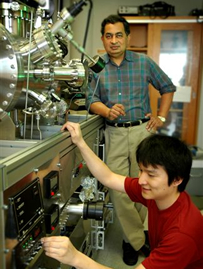Researchers on Team Discovering Superconductivity Advancement, Opens Way for Future Electronic Devices
By Chris Byrant

Shiny, black magnetic films, about the size of a penny and made by University of Alabama researchers, are central to a discovery of how to conduct resistance-free electricity in a manner previously thought impossible.
The research, conducted by scientists at Brown University, the Delft University of Technology in the Netherlands and UA, provides promising new leads for future electronics development. It published in a previous issue of Nature.
Scientists have demonstrated the ability to sandwich the magnetic material, chromium dioxide, between two superconductors in a way that allows an electrical current to pass through the magnetic material, while retaining the resistance-free benefits of the superconductors.
“Our role has primarily been in making these unique, high-quality magnetic materials,” said Dr. Arunava Gupta, a researcher in UA’s Center for Materials for Information Technology, known as MINT, and a co-author of the Nature paper.
While the samples’ surface area is about the same as a penny’s, the samples are considerably thinner, measuring only 1,000 atoms.
Previously, scientists had only been able to pass a current between two superconductors that were sandwiching magnetic materials, while the superconductors were only three to four atoms apart. In the latest discovery, the current traveled through the “sandwich” with the superconductors 300 times farther apart.
The discovery shows that some related long-held physics theories are incomplete, and it could also later positively impact a new field of electronics called “spintronics,” the researchers say. In spin-based electronics, or spintronics, the spin of electrons, as well as their charge, is captured and used in producing such things as improved circuits and computer chips.
The discovery indicates the presence of a rare type of “spin triplet” conversion of the superconducting current in the magnetic layer, the researchers say.
The benefit of superconductors, central in advances such as magnetic resonance imaging machines and passenger trains that travel at high speeds while levitating above their tracks, lies in these materials’ ability to conduct electricity without resistance. Resistance results in energy loss and is thereby undesired.
One of Gupta’s former UA graduate students, Dr. Guoxing Miao, now a post-doctoral researcher at MIT, is another of the paper’s co-authors.
Gupta, who is also a professor of chemistry and chemical engineering at UA, says potential applications of the discovery are difficult to predict, but he said it has the potential to lead to electronic devices with significantly lower energy requirements.
“You can combine these superconductors with these magnetic materials and potentially make novel devices where you could use an external magnetic field to switch these devices,” Gupta said.
Chromium dioxide is a material that was used for decades in producing both high quality audio and videotapes, Gupta said.
“We were one of the first to make high-quality thin films,” Gupta said of UA’s MINT Center. “Thin films are difficult to produce. If you don’t use the proper conditions you will produce a different material that does not have these unique properties.”
The discovery could also assist benefit MRAM, a new type of experimental computer memory. Unlike today’s standard memory, MRAM requires no extensive boot-up process and uses less power than conventional memory. It is also non-volatile, so if there’s a sudden power outage it would “remember” its state, preventing the computer user from losing data. Sensors, known as magnetic tunnel junction devices, are essential components in devices that might one day feature this next generation of computer memory.
The announcement in the Nature article could be another step toward making MRAM a reality for the average computer user.
“If we are able to expand this and make magnetic tunnel junction devices, you will see extremely large changes in resistance,” Gupta said.
The experiments announced in Nature were performed under extremely low temperature conditions. Temperatures much lower than room temperature are the only known conditions under which superconductors provide no resistance. Gupta says achieving similar results under room temperature conditions would be industry-altering.
“That is still the holy grail.”
Funding for UA’s portion of the research was provided to MINT by the National Science Foundation. UA’s MINT center is a multi-disciplinary research program focusing on information storage, including magnetic data storage. It was selected by the National Science Foundation as one of the 29 Materials Research and Science and Engineering Centers in the United States. MINT has continuously carried this designation since it first achieved it in 1994 as one of the 11 centers so recognized in the agency’s original selection.
Further Reading